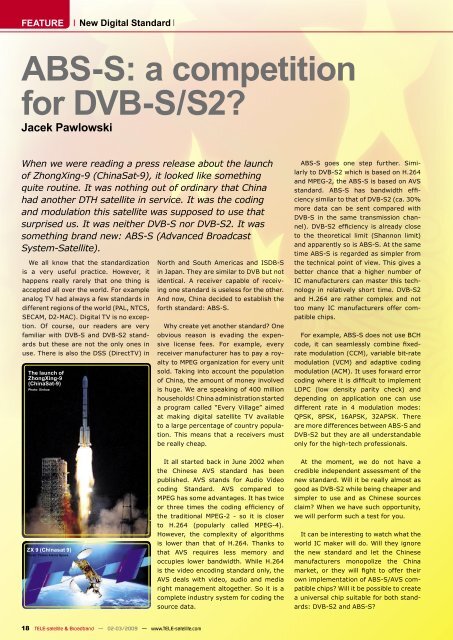02-03 - TELE-satellite International Magazine
02-03 - TELE-satellite International Magazine
02-03 - TELE-satellite International Magazine
You also want an ePaper? Increase the reach of your titles
YUMPU automatically turns print PDFs into web optimized ePapers that Google loves.
FEATURE<br />
ABS-S: a competition<br />
for DVB-S/S2?<br />
Jacek Pawlowski<br />
The launch of<br />
ZhongXing-9<br />
(ChinaSat-9)<br />
Photo: Xinhua<br />
ZX 9 (Chinasat 9)<br />
Photo: Thales Alenia Space<br />
New Digital Standard<br />
When we were reading a press release about the launch<br />
of ZhongXing-9 (ChinaSat-9), it looked like something<br />
quite routine. It was nothing out of ordinary that China<br />
had another DTH <strong>satellite</strong> in service. It was the coding<br />
and modulation this <strong>satellite</strong> was supposed to use that<br />
surprised us. It was neither DVB-S nor DVB-S2. It was<br />
something brand new: ABS-S (Advanced Broadcast<br />
System-Satellite).<br />
We all know that the standardization<br />
is a very useful practice. However, it<br />
happens really rarely that one thing is<br />
accepted all over the world. For example<br />
analog TV had always a few standards in<br />
different regions of the world (PAL, NTCS,<br />
SECAM, D2-MAC). Digital TV is no exception.<br />
Of course, our readers are very<br />
familiar with DVB-S and DVB-S2 standards<br />
but these are not the only ones in<br />
use. There is also the DSS (DirectTV) in<br />
18 <strong>TELE</strong>-<strong>satellite</strong> & Broadband — <strong>02</strong>-<strong>03</strong>/2009 — www.<strong>TELE</strong>-<strong>satellite</strong>.com<br />
North and South Americas and ISDB-S<br />
in Japan. They are similar to DVB but not<br />
identical. A receiver capable of receiving<br />
one standard is useless for the other.<br />
And now, China decided to establish the<br />
forth standard: ABS-S.<br />
Why create yet another standard? One<br />
obvious reason is evading the expensive<br />
license fees. For example, every<br />
receiver manufacturer has to pay a royalty<br />
to MPEG organization for every unit<br />
sold. Taking into account the population<br />
of China, the amount of money involved<br />
is huge. We are speaking of 400 million<br />
households! China administration started<br />
a program called “Every Village” aimed<br />
at making digital <strong>satellite</strong> TV available<br />
to a large percentage of country population.<br />
This means that a receivers must<br />
be really cheap.<br />
It all started back in June 20<strong>02</strong> when<br />
the Chinese AVS standard has been<br />
published. AVS stands for Audio Video<br />
coding Standard. AVS compared to<br />
MPEG has some advantages. It has twice<br />
or three times the coding efficiency of<br />
the traditional MPEG-2 - so it is closer<br />
to H.264 (popularly called MPEG-4).<br />
However, the complexity of algorithms<br />
is lower than that of H.264. Thanks to<br />
that AVS requires less memory and<br />
occupies lower bandwidth. While H.264<br />
is the video encoding standard only, the<br />
AVS deals with video, audio and media<br />
right management altogether. So it is a<br />
complete industry system for coding the<br />
source data.<br />
ABS-S goes one step further. Similarly<br />
to DVB-S2 which is based on H.264<br />
and MPEG-2, the ABS-S is based on AVS<br />
standard. ABS-S has bandwidth efficiency<br />
similar to that of DVB-S2 (ca. 30%<br />
more data can be sent compared with<br />
DVB-S in the same transmission channel).<br />
DVB-S2 efficiency is already close<br />
to the theoretical limit (Shannon limit)<br />
and apparently so is ABS-S. At the same<br />
time ABS-S is regarded as simpler from<br />
the technical point of view. This gives a<br />
better chance that a higher number of<br />
IC manufacturers can master this technology<br />
in relatively short time. DVB-S2<br />
and H.264 are rather complex and not<br />
too many IC manufacturers offer compatible<br />
chips.<br />
For example, ABS-S does not use BCH<br />
code, it can seamlessly combine fixedrate<br />
modulation (CCM), variable bit-rate<br />
modulation (VCM) and adaptive coding<br />
modulation (ACM). It uses forward error<br />
coding where it is difficult to implement<br />
LDPC (low density parity check) and<br />
depending on application one can use<br />
different rate in 4 modulation modes:<br />
QPSK, 8PSK, 16APSK, 32APSK. There<br />
are more differences between ABS-S and<br />
DVB-S2 but they are all understandable<br />
only for the high-tech professionals.<br />
At the moment, we do not have a<br />
credible independent assessment of the<br />
new standard. Will it be really almost as<br />
good as DVB-S2 while being cheaper and<br />
simpler to use and as Chinese sources<br />
claim? When we have such opportunity,<br />
we will perform such a test for you.<br />
It can be interesting to watch what the<br />
world IC maker will do. Will they ignore<br />
the new standard and let the Chinese<br />
manufacturers monopolize the China<br />
market, or they will fight to offer their<br />
own implementation of ABS-S/AVS compatible<br />
chips? Will it be possible to create<br />
a universal chip suitable for both standards:<br />
DVB-S2 and ABS-S?
















